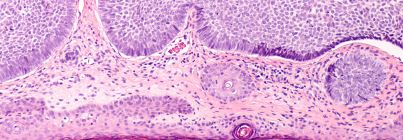Dermatological Surgery Treatments
Mohs Micrographic Surgery
Mohs surgery is state-of-the-art treatment for skin cancer in which the physician serves as pathologist and reconstructive surgeon.
More information on Mohs micrographic surgery at UC Davis
Surgical Excision
Excision is the surgical removal of the visible lesion plus a margin of surrounding tissue for pathological examination. The goal of surgical excision is complete removal of the lesion and cure, but excision can also be used to biopsy suspicious lesions. The procedure is performed to minimize scarring and functional impairment.
Surgical excision is a standard treatment for most types of skin cancer including basal cell carcinoma, squamous cell carcinoma, malignant melanoma, and other benign or malignant cutaneous growths on most areas of the body, except for the head, face and neck. These skin cancers are typically removed through Mohs Micrographic Surgery.
Curettage and Electrosurgery
Non-melanoma skin cancers (such as basal cell carcinoma and squamous cell carcinoma) and benign growths often are treated with curettage or electrosurgery. Curretage involves scraping of affected tissue with a sharp instrument) while electrosurgery uses heat from an electric current to burn, cut, and/or coagulate tissue. The combination of curettage and electrosurgery effectively treats the entire involved area by targeting the lesion and a margin of surrounding tissue.
Cryosurgery
Cryosurgery involves the application of liquid nitrogen or other agent directly to the skin to destroy skin growths. The liquid nitrogen is generally sprayed on the skin through a handheld device or is applied using a probe or cotton tipped applicator. Liquid nitrogen rapidly freezes and thaws cells which destroys areas where skin growths occur. Normal skin cells replace the damaged ones and heal the area naturally.
Cryosurgery is commonly used for many benign (non-cancerous) growths (such as seborrheic keratosis, verruca vulgaris, verrucous keratosis and lentigines) and pre-cancerous growths (actinic keratosis). Basal cell carcinoma and squamous cell carcinoma can also be treated with cryosurgery, in some cases. The treated area may briefly sting and develop temporary redness and the treated lesion crusts and peels off in one to two weeks.
Topical Skin Cancer Therapy
Non-melanoma cancerous skin growths (basal cell carcinoma and squamous cell carcinoma) and pre-cancerous growths (actinic keratosis) can often be successfully treated with topical skin cancer therapy. Topical chemotherapy agents destroy cancerous cells. Biologic topical agents stimulate your immune system to destroy cancerous cells while preserving the normal, neighboring tissue.
Most chemotherapy or biologic agents are formulated as creams, gel, or lotions that are applied directly to regions of the skin for a specified period of time. Affected areas of skin may become red, scaly, or crusty and may itch, sting, or burn during the treatment but heal quickly after the treatment is complete.
Laser Resurfacing & Chemical Peels
Removing the skin’s superficial layer through application of a chemical (alpha or beta hydroxy acids) or via laser light can effectively treat and remove pre-cancerous growths and some superficial cancerous growths. The face, scalp, and lips are the most common areas treated. Laser resurfacing and chemical peels remove layers of skin below the origin of the cancerous or pre-cancerous cells. After the peel, the skin heals quickly to a healthier state. Most common side effects are redness, mild swelling and peeling of the skin during the healing.
Photodynamic Therapy
Photodynamic Therapy (PDT) is a light based treatment performed in the office where a photosensitizing agent (aminolevulinic acid-ALA or methyl aminolevulinate-MAL) is applied and soaks into the affected tissue. The treated area is then exposed to light which stimulates the topical agent to destroy targeted areas, safely and effectively shrinking or eliminating growths. PDT is primarily used for pre-cancerous growths (actinic keratoses) and non-melanoma skin cancer (basal cell carcinoma and squamous cell carcinoma).
Radiation Therapy
Radiation therapy (RT) uses high-energy rays or particles to destroy, shrink or slow the growth of cancer cells. Radiation therapy is often the best treatment for large tumors, in locations that are difficult to treat with surgery, or in patients who cannot safely undergo surgery. RT can be used alone or in combination with other treatments Our dermatologic surgeons work closely with the UC Davis Radiation Oncology Department to develop individualized treatment plans for patients requiring RT.
If you would like to discuss any of our dermatology surgery procedures, please request a consultation to speak with our cosmetic dermatologists. Please call 916-734-6111 or 800-770-9282.


